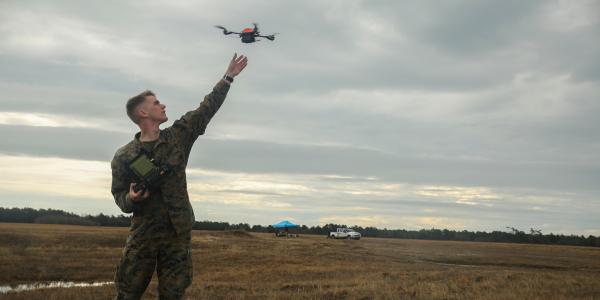A Pathway to More Resilient SATCOM
As the U.S. Defense Department goes full force into managing its terrestrial digital infrastructure of interconnected systems, it faces an additional challenge: connecting the moving dots involving space-based networks. Military satellite users want commercial service providers to develop more resilient and flexible communication networks based on open architectures to streamline shifts between military and commercial resources.
The department’s struggle is heightened by having to figure out how best to manage not only the hybrid of grids that comprises very different packet-based Internet protocol (IP) and waveform-based radio frequency segments but also the mix of commercial satellite providers, each with unique capabilities. The hodgepodge of commercially provided services and technologies supporting global data, voice and video operations is cumbersome and cost-prohibitive. There are different disciplines, with different languages, tools and techniques to manage, says Michael Smith, senior vice president of enterprise technology at San Diego’s Kratos Defense and Security Solutions. But, he says, “At the end of the day, those are just a component piece of a string of networks that needs to be tied together ... from service management and service assurance all the way through to signal protection.”
It is a tall order. The Defense Department needs a network management platform that can rapidly and seamlessly switch to another system if a satellite is degraded, Smith says. It also needs a platform to manage new and improved satellite capabilities, such as streaming video from drones enabled by the Army’s Warfighter Information Network-Tactical (WIN-T) program.
Commercial satellite communications (COMSATCOM) providers are hard at work to fill this order. Short-term leasing of commercial solutions has not been a cost-effective solution. When the Defense Department lacked sufficient satellite resources to carry out increased intelligence, surveillance and reconnaissance missions in Iraq and Afghanistan, it spent roughly $1 billion a year over a decade leasing them with overseas contingency operations funds. The arrangement meant that the government spent roughly four times more for commercial satellite bandwidth than it did on the Air Force’s Wideband Global SATCOM (WGS) system during that same period.
Though costly, the plan improved relations between the military and industry and forged common ground. One thing the two sides strongly agree on is the Defense Department’s need to harness significant commercial improvements, from high-throughput satellites to spot beam technologies and managed service delivery. Industry’s migration to managed service triggered the department’s Wideband Analysis of Alternatives to study options for meeting military SATCOM needs. If the study shows that commercial services are the best course for the department, it will need improved interoperability for network management, says Rick Lober, vice president and general manager of the Defense and Intelligence Systems Division at Hughes Network Systems in Germantown, Maryland. “Just as you have a cellphone from AT&T and a cellphone from Verizon, those are two different standards … but you can still call each other because everything is connected at higher levels, the IP level, in the network. That’s where we see interoperability occurring for the satellites,” he says.
Specialized technologies to streamline processes for better interoperability already exist in the commercial sector, offers Rajeev Gopal, senior technical director of Hughes’ Defense and Intelligence Systems. “All can coexist in the architecture when network management is orchestrated using different modems, different service providers and different types of waveforms,” he says. “Both mission assurance and efficiency can coexist, and they can coexist because each service is well-defined.”
Decision-making software can ensure that the right mission and the right priority get the bandwidth, Gopal continues, referring to a component of managed service plans. With these plans, commercial providers bear the equipment and manpower costs of network management, while the customer pays for a certain amount of continuous bandwidth instead of making ad hoc purchases.
“We’re not out there saying commercial should be used for everything,” Lober submits. “But just like they went away from the DOD telephone system in the ’60s and the cellular system in the ’80s, I think [the government] can start moving toward satellite managed services in the next couple of years.”
Network management plays a critical role in providing a resilient, protected backbone, particularly as potential nation-state enemies acquire more sophisticated systems, Gopal adds. “Enemies now have to worry about defeating not just one defense, but multiple defenses. The government has taken the right approach over the last three to four years to promote diversity in our solutions,” he says.
Satellite operator Inmarsat tackled resiliency from another angle. Its Global Xpress constellation is an end-to-end, high-throughput commercial network that spans the globe and complements military SATCOM. Engineers deliberately designed the single-operator system as a hybrid network that leverages Ka band along with the hardy L band because the former are susceptible to extreme weather conditions, says Rebecca Cowen-Hirsch, senior vice president of the U.S. government business unit at Inmarsat. “While we’re not going to change physics, we do have some really great engineers.”
Inmarsat’s IP-based communication technologies integrate into the network, creating a network topology connecting every node—in other words, designing a transparent network where IP talks to IP, Cowen-Hirsch explains. “From an integrated architecture perspective, there is a great advantage to managing end-to-end networks where satellite communications become just another node on the network,” she says. “This model represents an opportunity for the Department of Defense to view satellites as an extension of their network rather than a different node of communication. When taking an end-to-end approach to technology, such as Global Xpress, SATCOM as a service solutions appear like a telecommunication-managed service versus a traditional broadcast model of leasing transponder capacity, which makes integration into a network environment difficult.
“It takes a cultural shift to understand the integrated architecture model from a perspective of committed information rates and acquisition of SATCOM in megabit per second versus megahertz,” she adds. “This progressive model allows for SATCOM to be an integrated part of the network architecture.”
Automation is an inevitable but welcome byproduct of improved network management, experts offer. On one side of the coin, automation permits optimization of bandwidth allocation. Instead of buying ad hoc bandwidth for a high-level video conference, for example, automation could redirect unused bandwidth earmarked for logistics missions. “Today, if a mission has to take place, people literally have to make phone calls, send emails and buy some bandwidth—and each step is sort of a bottleneck,” Gopal says. “Something that with automation takes a few seconds or minutes now takes multiple weeks.”
On the other side of the coin, automation improves interoperability. As a result, Smith of Kratos highlights the Defense Department’s need to better manage its expanded fleet of drones and the increased number of flights that provide military commanders enhanced intelligence and greater firepower. “When they were running 12 drones in a mission 10 years ago, you can put a lot of time and effort across managing all of the component pieces across the 12,” he offers. “Now they’re running hundreds, and when adding some of the swarm technologies, you don’t have a choice but to automate.”






Comments